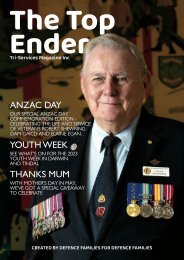The Top Ender Magazine October November 2020 Edition
Oct Nov 2020 Magazine
Oct Nov 2020 Magazine
You also want an ePaper? Increase the reach of your titles
YUMPU automatically turns print PDFs into web optimized ePapers that Google loves.
´ 13 Squadron
± Squadron Leader Craig Sedgman
Leader Sedgman said, adding, “In the words of combat aircraft historian, Bill
Sweetman, the Mosquito was: ‘A slightly nervous thoroughbred which could
perform impressive feats in the hands of the courageous and competent
… but would occasionally deal out a kick or a bite. Its power-to-weight ratio
and wing loading were both high, and its Vmc – the speed that needs to be
maintained to assure rudder effectiveness with one engine feathered and the
other running at full power –
Its power-to-weight
ratio and wing loading
were both high
was 172 mph (277km/h) or
more, probably the highest
of any WWII twin. There was
a substantial ‘no-man’s-land’
between lift-off and Vmc,
during which an engine failure was usually fatal. Below Vmc, power had to
be quickly retarded on the good engine to keep the aeroplane from rolling,
and this meant a loaded Mosquito could no longer maintain altitude.’”
So while the exact cause of the crash was never fully determined, what
does seem clear is that Mosquitos suffered performance issues in the takeoff
configuration, which could lead to fatal consequences under certain
conditions.
Squadron Leader Craig Sedgman
13 Squadron
continued on page 52
October/November 2020 51


















